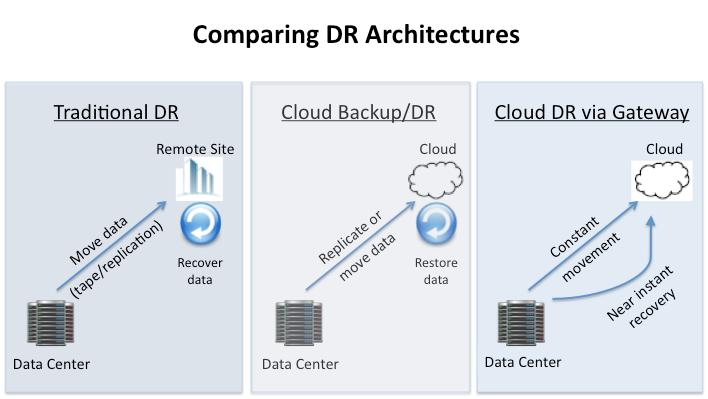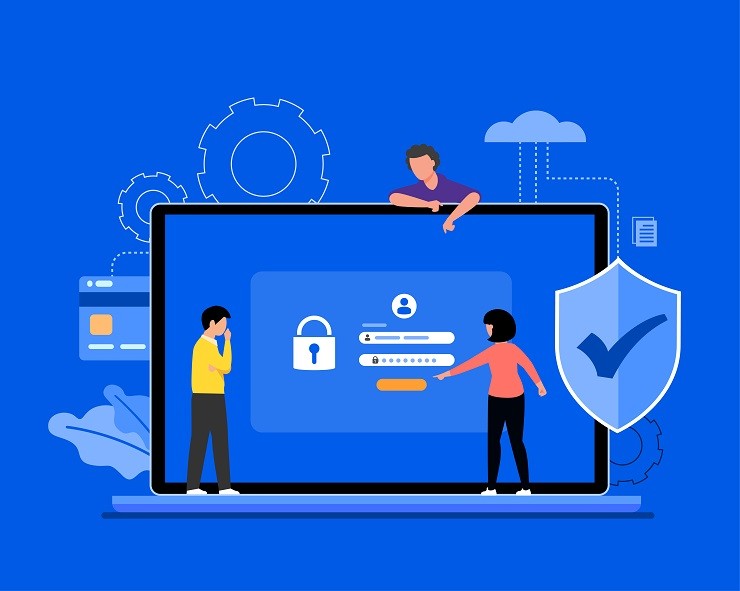Have you experienced an unplanned outage lately? Based on our conversations with IT administrators, there’s at least a 25% chance you have. Those that have experienced an outage recently may no longer be in the IT trenches. But if you’ve survived a painful outage, there’s a good chance you found out the hard way that a good number of the servers under your management have a critical role to play. Even a minor outage that renders one of those critical servers, or even a file, unavailable for a few hours can be extremely costly, if not devastating.
Small and mid-sized enterprises (SMEs) are particularly vulnerable to the consequences of such outages. These companies tend to be in a precarious position: they are large enough that an outage can do major damage in terms of compromised data or lost business, and yet many do not have adequate disaster recovery (DR) plans, tools and infrastructure in place to enable a rapid and effective response.
Until recently, effective DR practices required an IT practice unto itself – full blown duplicate IT infrastructure spread out to two or more different sites, along with all the hands-on systems and storage management that goes with it. The cost and complexity of these traditional approaches discouraged – and in many cases, prevented – SMEs from investing in DR planning and processes. But the advent of virtualization and cloud technologies has changed that picture dramatically.
With the recent emergence of virtualization and cloud storage technologies, it’s now possible to do DR in the cloud. Such solutions run the gamut, from simply duplicating data to the cloud as a form of off-site backup storage to creating a conduit between a customer’s site and a remote virtualized compute and storage infrastructure in the cloud.
Cloud-Based DR
In Taneja Group’s view, cloud-based DR has a specific definition. It is more capable than just cloud backup, and it is more efficient than remote co-location of equipment. Cloud-based DR is the use of connectivity to compute and storage resources hosted on remote, elastic, multi-tenancy clouds to enable more cost-effective and flexible protection of data at a distance. In terms of DR, that’s a recipe matched to SME needs.
The cloud can shrink the CAPEX required for traditional DR. There’s no need to invest in a remote DR facility, and even on-going costs are minimal because the cloud is economically priced and can allocate capacity and performance on demand, enabling the customer to pay only for the resources consumed. Moving DR to the cloud can also increase the flexibility of DR configurations and practices, and since clouds are designed for remote management, it may speed recovery. Compared to cumbersome and expensive tape-based DR practices (both on-premise and off-site) such capabilities can make routine testing practical, and mean a solution really works when it is needed.
Cloud Challenges For DR
But great technology aside, the promise of cloud-based DR has not yet been realized for many SMEs. Early adopters have run into a wide variety of complications, including challenges around access, security, ease of use, recovery time and effort, and provider lock-in.
Though one of the primary reasons users move to the cloud is to make their data universally accessible, native storage in the cloud often limits access. Cloud storage tends to be designed for programmatic access – an alphabet soup of HTTP REST and SOAP APIs and acronyms – which means there might not be any out-of-the-box way to access it as regular storage. If you’re thinking of building a cloud DR solution on your own, prepare for a lot of custom development.
The cloud also introduces latency and data movement challenges. For DR, you might not be able to ensure the right data is in the right spot at the right time, and you may have a train wreck of inconsistent data on your hands. Native, unassisted access to the cloud may leave data unencrypted in-flight or at rest. Moreover, if you try on your own to work with HTTP data stored as objects for DR – and need to invoke snapshots, backups, and other under-the-covers storage functions you take for granted today – you may never achieve a DR plan you can execute with confidence. Workarounds to these challenges may do little better than hamstring an approach to cloud DR, while a poor approach may require copying complete data sets, perhaps through a backup layer or, worse, through scripts. Aside from limiting breadth of support and/or adding to recovery times, administering such steps via command line or remote console can be daunting. And in the end, you will have achieved little more than cloud backup.
Not to be overlooked, the rush toward emerging opportunities also leaves many cloud-enabled DR solutions in support of only one, or at most two, backend cloud providers. If a solution has limited support, SMEs in effect realize a lock-in “double-whammy” – not only is the effort to move cloud data enormous, but now they need another device to boot, and they have to move data from two clouds across two devices. As a result, a “one-provider-fits-all” approach may wind up being a far from optimal fit.
Shaking Up The Classic DR Approach
Fortunately, innovators are tackling the challenges. They are better coupling workloads and data together, and providing simplified, easy-to-use, low-cost mechanisms to get both into cloud infrastructures, preserve data access, and manage them when there.
Since the challenge is data-centric, the leading innovators are storage vendors tackling the problem with technologies that push data into the remote cloud. By periodically synchronizing data, vendors enable workloads to switch to another site – either another physical location or entirely within the cloud itself. And by taking on the challenges at the storage layer, vendors can leverage what are already significant disaster recovery capabilities unleashed by server virtualization, including VMware’s Site Recovery Manager.
Solutions are coming from vendors with various backgrounds, ranging from backup products to hosting services to vendors specializing in “cloud storage enablement.” A short sample of vendors across that broad spectrum includes Acronis, CommVault, SunGard, and TwinStrata. While the cloud aspects of the solutions from some of these vendors may still be in their early stages of evolution, the offerings share a set of capabilities that are essential components of cloud-based DR:
Flexible integration with both sources and targets, including applications as well as cloud DR providers. Solutions shouldn’t force users to modify or customize their applications or file systems in order to take advantage of cloud-enabled DR. Nor should they entrap users into a single provider in what is today a rich cloud ecosystem of largely compatible compute and storage providers. While a number of vendors are coming at the challenge with backup technologies and agents, other vendors offer iSCSI appliances that store data locally while simultaneously connecting to cloud storage services such as Amazon S3, AT&T Synaptic Storage as a Service, or even remote private cloud storage built with platforms such as EMC Atmos. Under the covers the latter solutions can act as a conduit for directly storing data in the cloud, even though the storage seems local. Some of these solutions enable simultaneous use of multiple storage providers, and some even allow users to move transparently to a new provider, while data is gradually migrated behind the scenes. Irrespective of architecture, though, the right solutions for connecting DR into the cloud will enable choice and cost competition across cloud providers, with the right tools to enable easy provider migration if that time comes.
Ready for the virtual infrastructure. Key to making DR more affordable for SMEs is using a remote cloud where standby applications can be configured on virtual servers and can easily be turned up and down in a shared-cost, service provider cloud. There are various ways to move data to such virtual clouds so that virtual servers can access it just like physical and virtual servers do in the physical data center. Most approaches either include agents on physical and virtual servers – along with increased management complexity – or deploy virtual appliance versions of a particular storage technology in the virtual infrastructure. Vendors with physical and virtual appliance offerings may enable customers to satisfy their integration requirements in both local and cloud environments, and emulate the remote cloud environment on their own virtual servers. Moreover, a virtual appliance is simple to implement and can improve the effectiveness of DR planning by significantly reducing testing costs and allowing DR scenarios to be validated without disrupting the business.
A high level of data security and resilience. Leading solutions raise the bar on data security and integrity. Data can be highly secured with in-flight and at-rest encryption (AES is the standard today). Data integrity can be elevated by combing through and check-summing data more thoroughly as it is transmitted to the cloud. Furthermore, data stored by many of these cloud DR solutions can exploit the multi-site, automated replication capabilities of multiple cloud providers to protect offsite systems and data better than self-sourced solutions. Finally, the best storage technologies for building cloud DR can provide many flexible paths to securing data to meet a wide range of users’ needs. If the public cloud is not an option, look for cloud solutions that support private clouds in any number of configurations – ranging from secure, completely partitioned hosted offerings to complete onsite implementations using low-cost storage such as EMC’s Atmos. This combined set of capabilities will give SMEs peace of mind and enable them to more readily satisfy regulatory requirements for their key data and applications.
Closely integrated with existing and remote compute and applications. A DR technology that approaches DR from the storage layer should reach well beyond just the conveyance of data from one location to another. Protecting consistent, known-good data is the primary task, and can be approached with a variety of technologies ranging from backup to snapshot technologies along with agents or providers that tie in at the application level to guarantee that applications are quiesced and data is consistent – Microsoft’s VSS framework makes snapshots the de facto standard for integration with many applications. Moreover, since cloud DR will revolve around virtual infrastructures in the cloud, technologies should tie into frameworks for managing virtual compute, such as VMware’s vCenter or Microsoft’s SCVMM. More importantly, they should integrate with a system or toolset to orchestrate disaster recovery, such as VMware’s Site Recovery Manager, which is rapidly becoming the gold standard for DR management. Not all cloud DR solutions are built the same, and some may require steps that span the better part of an hour, or multiple hours. By tying into virtual infrastructures, efficiently moving data, and employing sophisticated snapshot and synchronization techniques, solutions can deliver cloud DR in a fraction of that time.
Sample Offerings
The door is just opening for many innovators to step into this market, but the solutions that are here today appear ready for prime time. Acronis, for example, has turned its imaging technology into a tool for protecting the data of SMEs. Acronis has also connected its technology with service providers to enable replication of protected data to the cloud, and recovery to DR systems in the cloud.
In another example, CommVault has a solution that couples backup to RackSpace cloud servers with CommVault-managed recovery across additional RackSpace cloud servers.
TwinStrata is another example. The company is leveraging native iSCSI with virtual and physical storage appliances that in turn keep a local copy of data in cache and a copy in the cloud. By deploying virtual appliances on different hypervisors in the cloud, executing snapshots that are automatically stored in the cloud, and leveraging integration with a DR orchestration offering such as VMware Site Recovery Manager, a TwinStrata customers can fail over in the event of a disaster to virtual servers running in the same cloud where their data is stored.
Various Paths To Cloud-Based DR
The movement to cloud-based DR is being enabled by a broad range of vendors and approaches (see Figure below). Each vendor applies its own unique technology to move disaster recovery to the cloud instead of the traditional secondary data center. Some vendors, such as Acronis and CommVault, will move backup data. Such solutions may require a recovery process in the cloud, but recovery can be “pre-staged” so that applications can be immediately restarted upon disaster.
Emerging cloud gateway vendors, when enabled by primary storage support and the ability to serve up storage from a virtual appliance, can in effect pre-stage data automatically and make it available to virtual servers in the cloud. Not all cloud gateway solutions can do this, but when they can they will further simplify the recovery process.
The many choices for cloud-based DR should allow SME users to more easily select a product that integrates with their existing technology and management practices, and should finally make DR practical for the SME.






